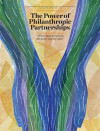Recently I learned something about the difference between the old and new San Francisco-Oakland Bay bridges. The old bridge had fixed supports; it was built to stand firm. The new bridge, however, has flexible supports, and the partnership of strength and flexibility—as difficult as it may have been to achieve—makes this bridge far more likely to last than the old one because it is able to withstand more stress. It is more resilient.
The Power of Philanthropic Partnerships

This special supplement looks closely at the lessons the Orfalea Fund has learned about how to create effective partnerships with nonprofits, government agencies, and other philanthropies.
-
“Where Two Rivers Meet, The Water Is Never Calm”
-
Migrating a Partnership Ethos
-
The Pillars of Partnership
-
Accepting the Challenges of Partnership
-
Valuing Stakeholders in Early Childhood Education
-
Early Lessons Propel a Movement
-
Building Disaster-Ready Philanthropy
-
Strengthening Santa Barbara County’s Disaster Resilience
-
Choosing the Right Partners for School Food Reform
-
A Changing Landscape for School Food
-
Lessons From a Sunsetting Fund
-
When to Lead, Follow, and Let Go
-
The Gates of Hope
Those of us in philanthropy take on complex problems that are hard to address and may be impossible to solve, and we do so in an ever-changing and stressful social, political, and technological landscape. To do well, we must be resilient. And we have to embrace the idea that partnership is an essential element of success.
Consider this: More than 80 percent of philanthropists today are entrepreneurs rather than heirs, and, understandably, in our philanthropic work we seek the familiar structures of business—the clear drivers and measures we have come to rely on, such as profits, market share, return on investment, and so on. In order to effect change over the long term, we must reconcile the business experience of our past with our long-term dreams for the community’s future. We must recognize that the work of philanthropy is not a head-or-heart battle. It never has been. It’s a head and heart partnership.
It is also clear that collaborative relationships are essential to our work. Only by partnering can we achieve positive, lasting change.
We chose a Ugandan proverb as the theme for this supplement—“Where two rivers meet, the water is never calm”—because partnership has been the theme of our philanthropic journey, and because partnership is not easy. We hope that our experience, captured in these pages, may help others navigate the often-turbulent waters of their own efforts to make a difference.
In “Migrating a Partnership Ethos,” Dean Zatkowsky describes how our family’s business experience influenced our approach to philanthropic collaboration. In “The Pillars of Partnership,” Barbara Andersen explains how we learned from mistakes and developed rules of engagement to ensure that our collaborative relationships were goal-directed and effective for all parties. Lois Mitchell and Peter Karoff remind us that “Accepting the Challenges of Partnership” means having both clarity of purpose and a willingness to embrace conflict as an opportunity for learning and growth.
We are very proud of The Orfalea Fund’s decade-plus of work in early childhood education, and the fact that our county’s preschools achieve accreditation at eight times the California average.* Adrianna Foss explains in “Valuing Stakeholders in Early Childhood Education” how partnering with the teachers and directors at early childhood development centers created a culture of quality that will continue beyond the fund’s involvement. We are honored to have Susie Buffett weighing in as well, on the Educare public-private partnership and what it represents to the future of both early childhood education and philanthropy.
Santa Barbara County’s advances in disaster preparedness are also a great point of pride because of the numerous and diverse partnerships required to make everyone in the county safer. Our friends from the Center for Disaster Philanthropy provide a global overview of the opportunity in “Building Disaster-Ready Philanthropy,” and Barbara Andersen’s accompanying article describes how such ideas were pioneered locally through the Aware & Prepare initiative.
Chef and School Food Initiative director Kathleen O’Hare de Chadenèdes set out to bring a private-sector mentality to a public-sector job, and offers two contrasting stories of how that worked out in “Choosing the Right Partners for School Food Reform.” Jessica Donze Black of the Pew Charitable Trusts, in her accompanying article, “A Changing Landscape for School Food,” provides powerful context for the rapidly growing school food reform movement. And “Lessons from a Sunsetting Fund,” by Catherine Brozowski and Tom Blabey, offers down-to-earth descriptions of the functional challenges that an organization reliant on partnerships faces when it winds down.
The mechanics of pulling back may be familiar to entrepreneurs in the business world, but feel unnatural in the nonprofit sector. That is why we chose to close the supplement with Lois Mitchell’s reflections on “When to Lead, Follow, and Let Go.”
At first, when we were choosing a theme for this supplement, I wasn’t sure that “Where two rivers meet, the water is never calm” would work. I thought it focused too much on the conflict inherent in partnerships. But today’s philanthropists are learning to excel at flexibility, partnership, and exploration. They are learning to be resilient. And as new generations bring their heads and hearts to the work of giving, social change will accelerate, just as technological change did under their stewardship. There will be turbulence, and there will be powerful progress. There is a Malawian proverb that says, “A big river is enlarged by its tributaries.” That is an equally apt metaphor for philanthropists because whether we believe ourselves to be traveling apart or together, we are always connected, and we are always in motion.
Support SSIR’s coverage of cross-sector solutions to global challenges.
Help us further the reach of innovative ideas. Donate today.
Read more stories by Natalie Orfalea.

